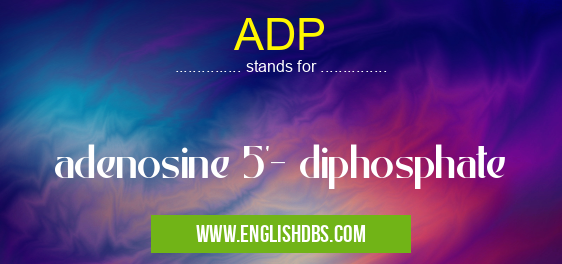What does ADP mean in PHYSIOLOGY
Adenosine 5’-diphosphate (ADP) is an important nucleotide found in the human body. It is essential for energy transfer and metabolism, and plays a major role in cell functioning. ADP is used as a source of energy to power various cellular processes such as muscle contraction, protein synthesis, and DNA replication. In addition, it helps to regulate the body’s chemistry by acting as an intermediate between two molecules. ADP also has a role in cardiovascular health, helping to keep cholesterol levels low and preventing heart attacks and strokes.

ADP meaning in Physiology in Medical
ADP mostly used in an acronym Physiology in Category Medical that means adenosine 5'- diphosphate
Shorthand: ADP,
Full Form: adenosine 5'- diphosphate
For more information of "adenosine 5'- diphosphate", see the section below.
» Medical » Physiology
What Does ADP Mean?
ADP stands for adenosine 5’-diphosphate, which is a molecule that serves multiple functions within the body. It is composed of nitrogenous bases adenine and ribose connected with 3 phosphodiester bonds. ADP serves as an intermediary in energy metabolism between adenosine triphosphate (ATP) and adenosine monophosphate (AMP). ATP is the primary form of energy used by cells, while AMP helps regulate metabolic pathways involving enzymes. When ATP is broken down into ADP, it releases one phosphate group that can then be used by other molecules for energy production or storage.
Medical Use of ADP
In medicine, ADP has several important roles including providing energy for cellular activities such as muscle contraction and nerve impulse transmission; activating enzymes involved in metabolic pathways; and being part of essential cofactors for proteins and other biomolecules involved in DNA replication, transcription, translation, signal transduction pathways, etcetera. Due to its importance in energy transfer which leads to increased activity within the cells of the human body, ADP may also play a role in treating certain medical conditions such as hypertension (high blood pressure), heart failure and stroke prevention.
Essential Questions and Answers on adenosine 5'- diphosphate in "MEDICAL»PHYSIOLOGY"
What is adenosine 5'- diphosphate (ADP)?
Adenosine 5'- diphosphate (ADP) is a nucleoside triphosphate involved in many biochemical processes. It serves as the primary intermediate in the production of adenosine triphosphate (ATP), an important biochemical fuel that powers cells. ADP has two phosphate groups attached to its sugar group, whereas ATP has three phosphate groups; this difference is responsible for much of the energy transfer between them.
How does ADP work?
ADP works by breaking down energies from other molecules such as glucose and converting it into ATP through a series of phosphorylation reactions. The breakdown process involves one or more phosphates being removed from the molecule, releasing energy which can be used for various metabolic processes. This process of transferring energy is known as energy transduction.
Where does ADP come from?
ADP is a byproduct of many metabolic pathways, such as glycolysis and the citric acid cycle. It is also synthesized during catabolism when energy needs to be generated or stored for later use. On the other hand, ADP can also be produced via deamination or hydrolysis of RNA molecules.
How is ATP created from ADP?
ATP is formed from ADP through oxidative phosphorylation, which occurs in specialized cellular structures called mitochondria. During this process, electrons are extracted from organic compounds and used to generate energy-rich molecules like NADH and FADH2. This energy is then used to transfer a phosphate group onto an existing molecule of ADP, forming ATP.
What role does ATP play in biochemistry?
ATP is an essential source of energy within cells and plays a key role in all cellular activities that require energy input. In most cases, this includes biosynthesis reactions that create proteins, nucleic acids, fats, carbohydrates and other biological compounds needed for cellular functions. Additionally, it serves as an intracellular signal molecule that relays information through phosphorylation cascades among other pathways.
What enzymes are required for generating ATP?
Enzymes responsible for producing ATP include kinases such as adenylate kinase and phosphofructokinase; these convert substrates such as ADP or AMP into their respective triphosphates forms - ATP orAMP–PPi – using high-energy intermediates such asNADH+/H+. Oxidative phosphorylation requires a number complex enzyme systems including cytochrome oxidase complexes I-IV.
How much energy does it take to form one molecule of ATP?
The total amount of free energy required to form one molecule of ATP depends on how it is made; but on average it takes around 7Kcal/mole(30KJ/mol) for each mole of energized substrates converted into one mole ofATPand two moles ofinorganic pyrophosphates.
Are there any dangers associated with high levels of ATPs if not properly regulated?
Yes - if concentrations are too high they can lead to cell death due to excessive metabolic activity or hyperactivity caused by too much stimulation fromATPsignals . High concentrations may also cause toxicity when high amounts are accumulated over time due to continuous production without proper clearance by cellular processes.
ADP also stands for: |
|
| All stands for ADP |
